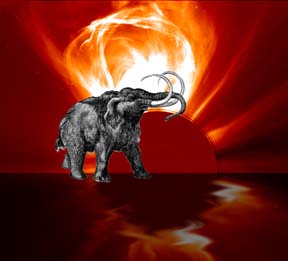
(To download a pdf copy of this release click here)

Graphic by Starlane Publications
***********************************
Contact: Paul LaViolette, Ph.D.
The Starburst Foundation
plaviolette@starburstfound.org
Further information on this topic at: www.starburstfound.org/superwave/YDextinct/p1.html
An active Sun and increased comet bombardment triggered by a Galactic cosmic ray volley may have led to the extinction of the mammoth about 13 thousand years ago according to research conducted by astrophysicist Paul LaViolette of the Starburst Foundation.
LaViolette first presented evidence for his theory in his 1983 Ph.D. dissertation which he worked on at Port land State University in Oregon. Astronomical evidence he had gathered indicated that every 10,000 years or so intense volleys of cosmic ray electrons are unleashed from outbursts of our Galaxy's core and make their way to us traveling at close to the speed of light. Further he reasoned that one such "Galactic superwave" had bombarded our solar system near the end of the ice age causing large quantities of cometary dust to enter the solar system a long with an increased influx of meteors and comets. He proposed that this triggered a sequence of events including the occurrence of super-sized solar flare outbursts that led to the extinction of the large mammals 13 thousand years ago.
He postulated that these superwave cosmic rays created a sheath of radiation around the solar system hot enough to vapo rize the surface of orbiting comets and fill the solar system with a dense cloud of cosmic dust. He theorized that the process also would have fragmented some comets and sent large chunks, some of comet size, careening into the inner solar system. He proposed that the presence of this dust had affected the Earth's climate and aggravated the Sun, causing it to create giant solar flares. During this extended two millennium period, he says, Pleistocene megafauna were being plagued by elevated UV radiation and catastrophic floods of glacial meltwater discharged from the surface of the ice sheets. He proposed that at least one giant-sized solar coronal mass ejection may have been strong enough to overpower the Earth's geomagnetic shield and scorch the Earth, thus creating the final chapter in the decimation of the megafauna whose remains in some cases are found to have abnormally young radiocarbon dates. He elaborates on this in his book Earth Under Fire as well as in various journal papers. LaViolette apparently is on the right track since data that later came out showed that atmospheric radiocarbon experienced an anomalous 7 percent increase over the period spanning the Younger Dryas transition boundary.
In the early 80's, as a key test of his theory, LaViolette had analyzed samples of polar ice for the presence of iridium and nickel. He found that on at least six occasions during the mid and early stages of the last ice age cosmic dust incursion episodes had occurred. His theory predicted that he should also find high concentrations of cosmic dust during the interval from 11,000 to 14,000 years ago that spanned the extinction of the large Pleistocene mammals. But at that time he was unable to complete this crucial test of his theory because of lack of available ice samples spanning this interval. At that time, LaViolette's findings were considered quite novel, particularly his discovery that certain ice age polar ice samples contained high levels of tin along with iridium and nickel, for such high tin concentrations had never before been seen in extraterrestrial material.
Now, however, a group of 26 scientists, led by Lawrence Berkeley Lab scientist Richard Firestone and geologist Alan West, has found evidence that high levels of extraterrestrial material are present at the 12,900 year old Younger Dryas mass extinction boundary, thus confirming LaViolette's 24 year old prediction. As described in their paper in the October 9th issue of the Proceedings of the National Academy of Sciences, the Firestone- West "Younger Dryas boundary (YDB) group" found high concentrations of iridium, nickel, tektites, fullerenes, nanodiamonds, and helium-3 at this boundary, a date that also marked the end of the two-millennium-long megafaunal extinction episode (Firestone, et al., 2007). In particular, part of the YDB group (Darrah, et al., 1977) reported that magnetic separates from the YD boundary contained high levels of tin and copper, thereby corroborating LaViolette's earlier conclusion that the tin he had found was of cometary dust origin and evidence of a past superwave passage.
(more…)